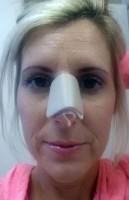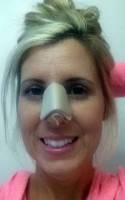Rhinoplasty Cartilage Graft Healing
Grafts usually refer to pieces of cartilage that can be taken from inside the nose (the septum) form the ear, or even from the rib to be used for camouflage or projection deficiencies such as on the dorsum of the nose or the tip.
These are mainly used for aesthetic improvement but can be used for functional problems such as for breathing disorders. (Steven Wallach, MD, Manhattan Plastic Surgeon)
A graft is a piece of cartilage taken from within the nose or behind the ear. It is used to build up the nose for structural integrity, improve breathing or to enhance the appearance of the nose.
Cartilage from the nose is the preferable graft. (William Portuese, MD, Seattle Facial Plastic Surgeon)
Rhinoplasty grafting
A graft is a piece of your tissue that is moved from one area to another location. Most commonly during a rhinoplasty a portion of unessential cartilage is removed from your septum and used to add support to the tip, open your airway, or help to alter the shape of your nose.
Because it is your own tissue, there is no risk of rejection. (Randy J. Buckspan, MD, Austin Plastic Surgeon)
Simply stated, a graft is a support structure placed underneath the skin of the nose to straighten, strengthen, or rebuild the cartilage framework.
A graft usually refers to the patient’s own tissue (autologous) but it can refer to synthetic (alloplastic )material such as solid silicone, medpor, Gortex, etc.
Most rhinoplasty surgeons prefer to use the patient’s own septal cartilage for grafts, which is borrowed from the central portion of the nasal septum. For revision rhinoplasty in which the septal cartilage has already been used, surgeons frequently will use ear cartilage or rib cartilage. Common uses of grafts in rhinoplasty include:
- Columellar Strut – a graft placed in the column of tissue between the ostrils (columella) to provide the tip with support or to increase the amount of projection.
- Tip Graft – cartilage placed overlying the tip to give more definition or projection to the tip.
- Spreader Grafts – pieces of cartilage that are placed along either side of the top of the septum to help widen a narrow bridge or to open the nasal passages.
- Alar Batten Grafts – placed in the sidewalls of the nostrils to prevent or correct nostril collapse
- Dorsal Onlay Graft – graft placed along the bridge to add height (dorsal augmentation) (C. Spencer Cochran, MD, Dallas Facial Plastic Surgeon)
Cartilage grafts in rhinoplasty
Rhinoplasty is a popular and effective surgery to recontour the shape of your nose. There are multiple techniques that a surgeon can use in rhinoplasty to contour and improve the definition of your nose. If the surgeon needs to build up or reinforce the area of your nose, they may choose to use a cartilage graft. This is a small piece of cartilage that was taken either from your septum, the cartilage in your ear, or even a portion of your rib. These cartilage grafts can improve the definition of the nose and add volume or height where necessary. (Pat Pazmino, MD, Miami Plastic Surgeon)
Grafts in rhinoplasty
A graft is a piece of tissue that is transplanted from one location to the other in the body. We often use cartilage grafts in rhinoplasty ( and less frequently soft tissue or bone grafts) to add structure and support which makes the nose look and function better. (Jason B. Diamond, MD, Beverly Hills Facial Plastic Surgeon)Graft is tissue moved from one part of body to another
In rhinoplasty grafts are most commonly cartilage taken from the nasal septum, ear, or rib. These grafts are used to strengthen, restructure, camouflage, or re-orient certain areas of the nose. (David W. Kim, MD, Bay Area Facial Plastic Surgeon)
Grafts used for a rhinoplasty
Nasal grafts are usually done using cartilage from the nasal septum or behind the ear, rarely bone from the skull, rib or the pelvis. Foreign materials such as silicone can also be used, but these are usually termed implants, rather than grafts. Cartilage grafts are most often used to straighten a nose or to repair poor results during revision surgery. (Howard T. Bellin, MD (retired), Manhattan Plastic Surgeon)
Grafts are tiny pieces of cartilage that are placed to achieve a particular purpose
A graft is a small piece of cartilage or other material that is placed within the nose.
For example, if you want to build up the dorsum of the nose, you can fashion a dorsum graft which is a piece of cartilage that is placed to augment the dorsum of the nose.
Other grafts can augment the radix or root of nose, cand camouflage concavities in the nasal bones and on and on. (Raghu Athre, MD, Houston Facial Plastic Surgeon)
Grafts in Rhinoplasty
Grafts are either a portion of your body (such as cartilage, bone, or soft tissue) or artificial material (such as silicone, Gore-tex, Medpore, etc) which serves to reshape the nose.
Grafts can be used in a functional capacity or to reshape the nose. For more detailed information on grafts and their use in rhinoplasty see attached link. (Anil R. Shah, MD, Chicago Facial Plastic Surgeon)
Nasal grafting
Nasal grafting is taking cartilage and, occasionally, bone or soft tissue from another source on your body and placing it in the nose very precisely to change the shape. A graft is moving tissue from one place to another. (Talmage J. Raine, MD, Champaign Plastic Surgeon)
Grafts used in Rhinoplasty
There are a couple of categories of grafts.
- Cartilage Ear Internal Nose Rib
- Bone Skull Rib
- Synthetic These grafts are used base what is available and what is needed to execute the rhinoplasty. (Earl Stephenson, Jr., MD, DDS, Atlanta Plastic Surgeon)
The MEANING of Nasal GRAFT
A Graft is not unique to surgery it is much more commonly used in gardening to create stronger trees or hybrids by introducing one plant whose characteristics a gardener like with another. In Surgery a graft may be defined as “piece of body tissue that is surgically removed and then transplanted or implanted to replace a damaged part or compensate for a defect”. Accordingly, we we use skin, bone and cartilage as grafts in many applications and situations.
In nose surgery, we frequently use cartilage grafts (from the septum, ear or even ribs) and less frequently bone grafts to support the breathing passages, support the nasal tip, elongate the nose, support a collapsed nose and get better tip definition am,ong many other uses.
When our body does not have the proper grafts, occasionally surgeons would use made made (Alloplastic) materials for the same purposes. But these are associated with a higher rate of complications. (Peter A. Aldea, MD, Memphis Plastic Surgeon)
Nasal grafts for rhinoplasty
Nasal graft usually refers to a piece of cartilage, bone or some other tissue that is used during rhinoplasty. Typically this is patient’s own cartilage, but can be banked tissue as well. It is used for either structural and functional reasons, or for aesthetic reasons to achieve a particular nasal appearance. As you probably have learned by now rhinoplasty is one of the more difficult procedures for a surgeon to master. The decision to use a nasal graft when used properly can greatly enhance the surgical result. It is imperative that an experienced and talented surgeon thoroughly assess the patient’s facial anatomy and proportions.
The goals is to create a beautiful nose with nice proportions that fits that particular face. In my practice we offer computer imaging to our prospective rhinoplasty patients, so that the goals and aspirations of the patients can be communicated. Of course not all surgeons that can created changes on the computer can produce those changes in the operating room. Pick you rhinoplasty surgeon carefully. You might find it insightful to read my article “The Art of Sculpting the Nose” which can be found on my web site under “publications” (Boris M. Ackerman, MD, Newport Beach Plastic Surgeon)
Rhinoplasty | Grafts
A graft is used to add structure to the nose, often to build up the dorsum (bridge) or the tip. Grafts can be from your own tissue (nasal, ear, or rib), a synthetic implant, or even from a cadaver source. Using grafts in rhinoplasty and revision-rhinoplasty is very common. (David Mabrie, MD, Bay Area Facial Plastic Surgeon)


